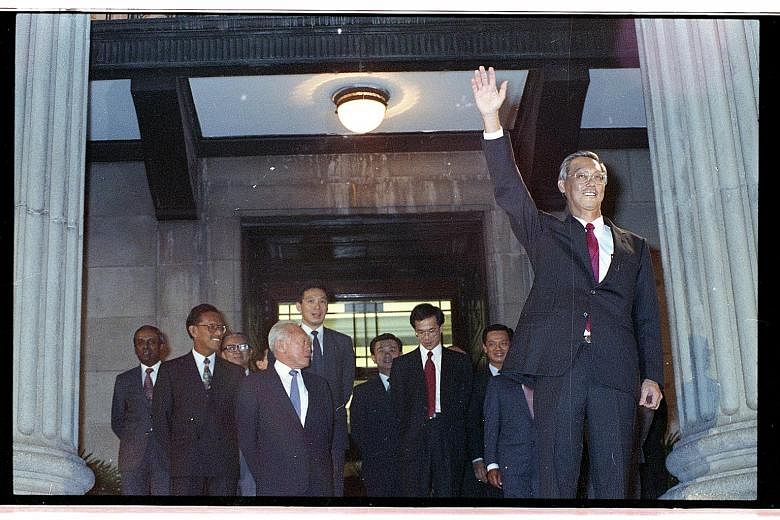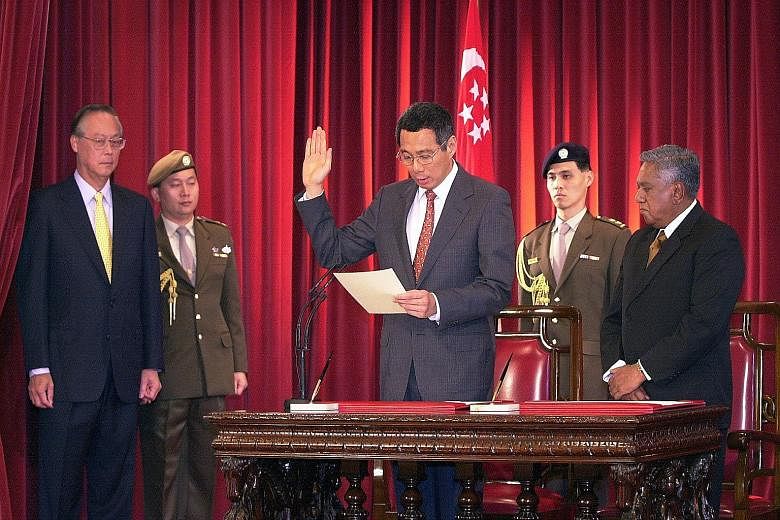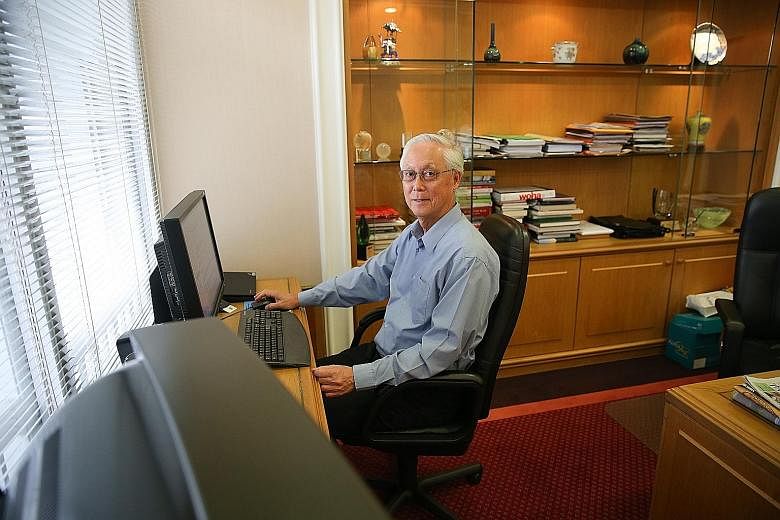By design, what should have been a seismic change in Singapore's political landscape was instead a non-event.
Nov 28, 1990, was the day of Singapore's first leadership transition: Mr Goh Chok Tong was sworn in as Prime Minister, taking over from Mr Lee Kuan Yew, who had held the mantle for 31 years.
Few democratically elected leaders stay in office for so long. Even fewer independence leaders from the 1960s prepare so assiduously for succession. Even more improbable was how the Singapore Government managed to make the moment entirely ordinary.
That was an achievement Mr Lee, Mr Goh and their colleagues had worked hard for.
"Looking back, that day did mark a historic moment. Symbolically, I represented a young Singapore walking out from Mr Lee's era of independence," said Mr Goh in an interview last month.
-
SUCCESSION TIMELINE
-
• 1966: Mr Lee Kuan Yew expresses concern over "very thin crust of leadership".
• 1976: Finance Minister Hon Sui Sen asks to retire from Cabinet, a request which had a "profound influence" on Mr Lee's search for the next leaders.
• 1972-1980: Key members of second-generation leadership team enter politics: Messrs Goh Chok Tong, Ong Teng Cheong, Tony Tan, Lim Chee Onn, S. Dhanabalan, Ahmad Mattar and S. Jayakumar.
• 1984 and 1988: Old guard ministers Goh Keng Swee and S. Rajaratnam leave Cabinet.
• 1984: Second-generation leaders decide among themselves on Mr Goh Chok Tong as first Deputy Prime Minister.
• 1990: Mr Goh sworn in as PM. Mr Lee stays on in Cabinet as Senior Minister.
• 1991: Dr Tony Tan and Mr S. Dhanabalan resign from Cabinet.
• 1992: Both deputy prime ministers Ong Teng Cheong and Lee Hsien Loong are diagnosed with cancer; Mr S. Dhanabalan returns to Cabinet to take over Mr Lee's duties at the Ministry of Trade and Industry.
• 1995: Dr Tan returns to Cabinet at Mr Goh's request to shore up the Government while both DPMs receive treatment.
• 2004: Mr Lee Hsien Loong is sworn in as Prime Minister. Mr Goh stays on in Cabinet as Senior Minister; Mr Lee Kuan Yew becomes Minister Mentor
• 2011: Nucleus of the fourth-generation leadership team inducted: Messrs Chan Chun Sing, Tan Chuan-Jin, Lawrence Wong and Heng Swee Keat.
"Leading up to it, I was already well-prepared as the Deputy Prime Minister to Mr Lee. Hence, I was not really anxious... our Singaporean tradition of leadership succession is unique, as with almost everything you see in this country. Nothing is left to chance. We try to remove excitement from succession planning."
By that November evening, Mr Goh had been PM-in-waiting, chosen by his peers, for six years. He and his second-generation colleagues had been running the day-to-day business of the country for some time.
In fact, Mr Lee had wanted the handover to take place in 1988 when he turned 65. But Mr Goh was not ready.
Two years later, he was.
Mr Goh chose to signal continuity, yet make clear that a new, younger generation was now in charge. So he chose City Hall as the venue for the oath-taking ceremony, the same historic place where Mr Lee was sworn in as Singapore's first prime minister in 1959, while picking a brown suit with a red tie for the ceremony - "something youngish and not severe".
In his 15-minute speech, his first address to the nation as PM, Mr Goh sought to strike the same balance. "The core tenets of governance for Singapore remained relevant when I took over, and even today. But a young generation of post-Independence Singaporeans had come of age in 1990. I decided on continuity and, at the same time, to offer a fresh approach and style in governance," he said.
"Mr Lee planned the leadership handover to ensure that Singapore would continue to thrive after him. I saw it as my responsibility 'To Serve, To Keep Singapore Thriving and Growing' (the theme of my speech). I spoke from my heart. I also made clear that I would lead Singapore in my own style or, as I put it then, wear my own shoes and choose my own stride."
Over the next 15 years, Mr Goh went on to do just that, ushering in a kinder, gentler era marked by a consultative style of governance, an opening up of civic space and a new focus on support for the disadvantaged - from Edusave grants for students to the Medifund scheme to pay medical bills of the poor.
After his speech, Cabinet members walked out to the steps of City Hall where a crowd had gathered, to Mr Goh's surprise.
In that pre-Internet age, little official effort went into "capturing history or trying to make it a specially memorable or impactful occasion", recalled Mr Goh. "We did not even set up a huge TV screen outside City Hall for people to watch."
But history intruded anyway. Seeing the crowd, Mr Goh stepped forward with Mr Lee Kuan Yew and Mr Lee Hsien Loong, who would take over as Singapore's third prime minister 14 years later. That picture of the three has become an iconic one in the annals of Singapore history.
"That picture on political succession speaks more than a thousand words," recalled Mr Goh.
In the crowd waiting to greet him that night were familiar faces - his supporters from Marine Parade, the ward he represented from 1976, and which he still represents as a backbench MP today.
At the reception which followed at the Westin Stamford hotel, he remembered that a queue of people came up to congratulate him.
He said: "The diplomats did so too. Perhaps some wanted to size up the new PM.
"But, for me, the warm handshakes with Singaporeans were more memorable. They looked to me, as Prime Minister, to carry their burdens and aspirations."
The evening ended quickly and the new PM went straight home - no separate private party or champagne - and was in bed at his usual time, just after 11pm. He had a Cabinet meeting to chair the next day.
When it came time for him to pass on the baton, Mr Goh replicated his own uneventful transition. Mr Lee Hsien Loong took over as Singapore's third prime minister on Aug 12, 2004, with nary a hiccup in the workings of the state.
Some 25 years after that first historic leadership handover from Mr Lee Kuan Yew, Mr Goh expresses the hope that leadership transitions in Singapore will continue to be unexciting. The Republic's system of grooming successors is a key factor underpinning its political stability and good governance, he said.
Said Mr Goh: "Time passes so quickly. Today, we are on the cusp of another leadership change.
"The fourth-generation leadership team is being put in place, but a new leader of the team has yet to emerge. It is getting urgent."



